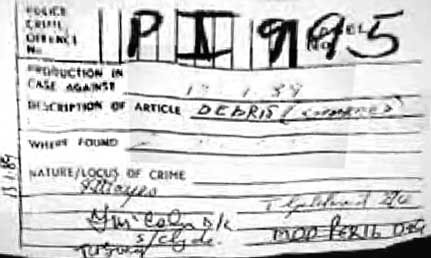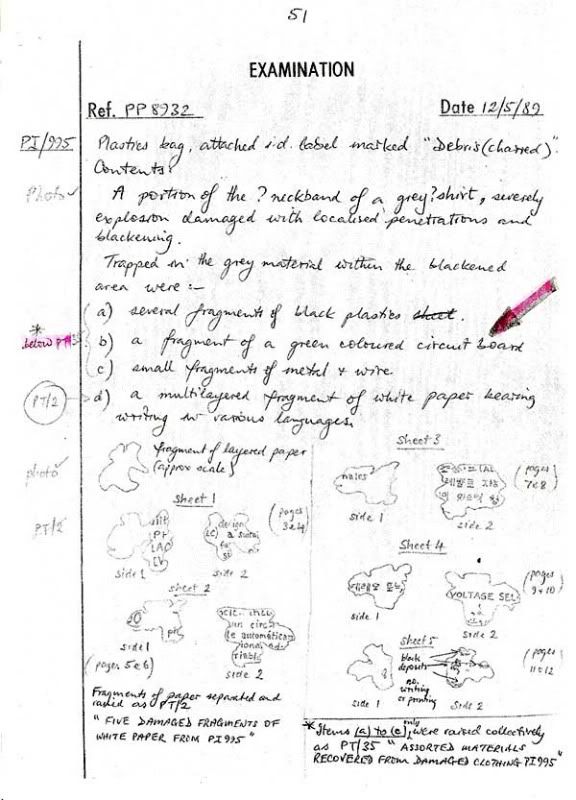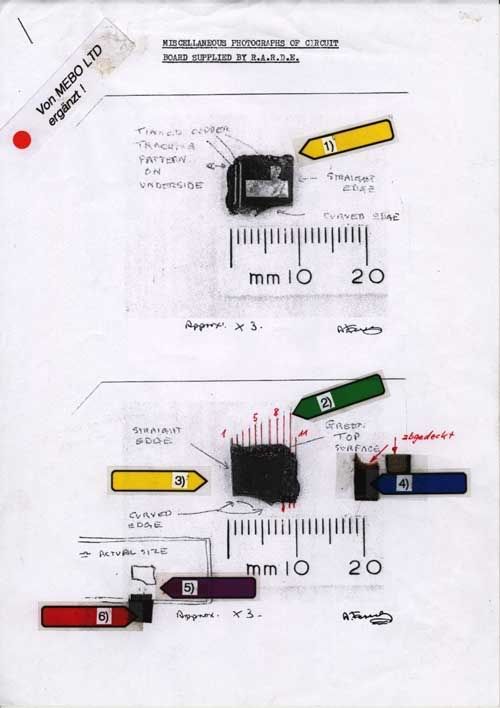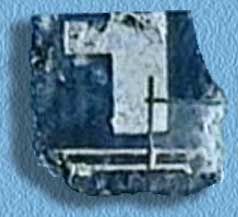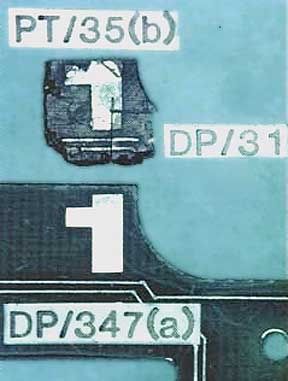March 17 2010
Last update May 1
Note: The main point of this post is seriously questioned or mooted by my later discovery that the primary suitcase model was made of gray plastic, simply coated with a brown film. I'll leave this up for whatever its information is worth as scrap, but it doesn't drive like it did.
Following is a partial list of evidence recovered by police that are probably fragments of the IED suitcase(s). These items were discussed at the Camp Zeist trial in 2000, all described as fragmentary, burnt, and mostly brown/copper, hard suitcase plastic. Some give an account of fragment size, shape, and condition. No photos are publicly available.
The find locations for these fragments are of two types – in-field and in-store. Some of special interest were labeled individually where they were found, with coordinates usually given. Other times there were too many to label all given the bad weather or whatever, and were bagged together, marked for the sector and taken to Dexstar or, usually here, Longtown, where the plane fuselage was being re-built. Those found at “CAD Longtown” as given only have the sector letter for location; there were eleven search sectors, named A-K. Most of the pieces we’ll examine came from sectors I and K, near the easternmost edge of the debris field, 35 miles from Lockerbie and beyond.
Witness 309, a Lothian and Borders police officer named Thomson, explained to the court how searchers were told what to look for, apparently once they’d found enough pieces of the presumed IED case. As Thomson recalled it, hard-sided, brown, and Samsonite were the three key features to watch for. [p 924-27] He also assured the record it was impossible to recover every bit of small debris, especially when caught in the spruce canopy of Newcastleton Forest, where much of the evidence did land.
Whether searchers knew it or not, there was always good reason to wonder about two brown hardshell Samsonites reported in the same corner of container AVE4041 the bomb suitcase (same model) later exploded in. Only one such suitcase was apparently found, but as we'll see, it was in two colors.
As I was compiling the brown suitcase chunks, I ran across a few mentions of highly fragmented, blast-damaged, hardside suitcase material – exactly what we’d expect for the IED case but for the color – usually given as “grey.” I had dismissed these as irrelevant to my two bags notion, until I stumbled upon this passage from Emerson and Duffy’s 1990 The Fall of pan Am 103, regarding severely blast-damaged suitcase fragments found east of Lockerbie:
“The fragments were a whitish blue. But that hadn’t been the original color of the bag. Further examination showed that the bag had been a Samsonite, a hard-sided suitcase. Purchased new, it had been copper-colored. In the heat and violence of the explosion, the copper had been bleached out to a pale blue. Specialists at Fort Halstead determined conclusively that the copper-colored Samsonite had contained the bomb in a radio-cassette player. They had found the bag that contained the bomb.” [p 191]This adds a wrinkle, if it’s true (and that’s a big if – Emerson and Duffy got a number of other points wrong). But “whitish-blue” might also be called gray, so below are listed both types, first brown, then gray, sub-organized by date of find. Citations are sporadic, mostly day five or so of proceedings.
Brown:
23 December - Label 73: "a piece of brown suitcase,” found at: unsure exactly. Marked with “an identifying mark, which I've put as 125, DAI.” No further description. [Day 4 witness 202, Ion, Dumfries and Galloway police]
14 January - Label 28: “piece of suitcase with puncture holes. Where found, I sector, under 507 859. 14/1/89. […] It is -- it is a piece of hard suitcase with various bending marks on it. It's a charred part and some holes pierced through it.
Q And what colour?
A It is brown.”
size: shown, not spoken.
17 February - Label 29: "Piece of fragmented, hard, plastic - brown colour, possible suitcase. Where found, Sector I, Longtown." “it's a hard, plastic, brown-coloured material.” Size: shown, not spoken. Two police labels attached.
6 March - Label 30: “"Piece of brown suitcase [possible blast damage]” Found: I Sector in CAD Longtown, 6/3/89. Size: “It's in an L-shape, 7 or 8 inches by 5 inches, 6 inches.” [750-51]
Witness 119 Duncan McInnes, Strathclyde Police, day 5
7 March - Label 53: "suitcase (part of), brown colour, charred edges, found in K Sector, CAD Longtown." "It appeared to be part of a -- what may be a Samsonite suitcase. It's plastic material that appears charred and ragged around the edges. It's about 10 or 11 inches long, brownish coloured on one side and black on the other." [pp 827-28]
10 April - Label 48: “piece of suitcase, found in I Sector, grid reference 482 854, on the 10th of April 1990." “It appears to be a bit of Samsonite with jagged edges, brown on one side […] and dark coloured on the other. Approximately an inch and three-quarters by an inch and a half. [p 833]
27 April - Label 33: “Piece of brown suitcase [possible blast damage]." Found: “Newcastleton Forest, I Sector, with a grid reference of 509 859, and dated 27/4/89.” [Witness 119 Duncan McInnes, Strathclyde Police, day 5]
9 May - Label 36: "Rubber trim," and in brackets, copper-coloured." I've also written, "Brought in at that time, possibly from the bomb case." Found: “Newcastleton Forest.”
18 May - Label 39: A small fragment of bronze coloured hard suitcase/charred, found in Newcastleton Forest, Tinnisburn, grid ref 458 849. “One and a half inches long. It's an irregular shape. It's about three quarters of an inch, narrowing down to a quarter of an inch.” [p 942-43]
19 May - Label 41: "Piece of brown suitcase, blast damaged."
A "Found in I Sector" with a grid reference of 476 854. And the date, 19/5/89.
Q What sort of size is it?
A One and a half inches by three-quarters of an inch.
24 May - Label 43: "A piece of brown-coloured suitcase, blast damaged. Found in Newcastleton Forest, Redmoss, grid reference 847 457, on the 24th of May 1989".
It's a small piece of what appears to be plastic or Bakelite material, brown in colour. [p 982]
16 June - Label 47: “a piece of -- it looks like "brown," in brackets -- I can't read part of it, but in brackets, it says: Samsonite suitcase found in the Border Forest Park, 430 847.”
19 June - Label 46: "Part of a brown suitcase, possibly Samsonite." Found: "Border forest park. Grid reference of 428 848," 19/6/89.Size: “Three inches by one and a half inches.” [p 758-59]
Gray:
13 Jan - Label 82 AKA police number PI 990: “…charred pieces of a suitcase found in I, 502 858, by T. Gilchrist, on the 13th of January '89.” A secondary label, "Debris (charred), found I Sector, 502 858," in my writing. Refers to the same.” [DI T. Gilchrist, p 855-56]
“described as a small, charred piece of grey plastic suitcase.” [p 1054]
20 February – (label?), police no. PH/773, we can see is grey/white material, suitcase interior.” Logged 1.40 p.m. on the 22nd.
“Q Underneath are the words "Joseph Patrick Curry" in red?
A That is not my handwriting.” Witness no. 127, Findlay, p 1074-75]
6 March - Label 81: "Piece of grey plastic with soot marks [possibly suitcase]."
Found: K Sector, CAD Longtown.
“Q You indicate that you had written on the label "possibly suitcase." What was it that made you think that?
A The type of material it was, basically.
Q What sort of size of article is it?
A Much smaller than the last piece; about, I would say, three and a half inches by two inches.
Q And what colour is it?
A Grey.” [p 748-750]
25 April - Label 91: “a piece of grey plastic.” Found: “grid reference 509 859, Newcastleton Forest.” “It's about an inch square, and it's quite ragged around the edges.” [p 831-32]
27 April - Label 87: "Piece of grey-coloured suitcase, I Sector, grid reference 509 859." [p 981]
No date given - Label 83: "Piece of charred material [possibly part of a suitcase]." Found: I Sector at CAD Longtown. “It's a grey coloured -- appeared to me to be plastic material, hard plastic material … It's a fragmented shape, I would say… Eight inches by five inches or so.” [McInes, pp 747-48]
No date Given - Label 98: "Piece of grey material, possibly suitcase, found debris, K Sector, Longtown." “a piece of grey plastic Bakelite-type material.” [p 979-980]
Unsure, possibly related:
16 February - Label 89 "piece of fragmented and charred material. [possible suitcase]" Found: “Sector I, Longtown." No further details. [pp 874-75]
10 March - Label 113: "Piece of material [possibly suitcase]” Found: K Sector, Longtown, on 10 March 1989." [p 978]
18 April - Label 31: "Small piece of badly scorched suitcase (possibly bomb case)." Newcastleton Forest, I Sector, grid reference number 508 858.
“It's probably just over -- maybe an inch and a half in length; and width, probably an inch. Maybe just slightly less.” [p 902-03]
25 April - Label 32: "suitcase (piece of), charred, found in I Sector, grid reference 509 859 … It's an oblong piece, about an inch and a half by one inch, a tear through the middle of it. It's dark coloured. It's hard to differentiate any other colours.” [p 830-31]
17 May - Label 94: "Small piece of charred suitcase.” Found: I Sector, 474 853. “a small piece of charred suitcase, approximately one inch by half an inch, again with jagged edges.” [Gilchrist]
26 May - Label 44: "Small piece of what appears to be IED case." Color not given. Found: “I Sector, Redmoss area, grid reference 847 457.”
Analysis:
It's difficult to say much about the spread of the fragments at the moment. Nearly all were found in I or K sector, from those given. These are the furthest east, with A sector itself at Sherwood Crescent Lockerbie, and K being near the North sea. Newcastleton Forest is I believe within I sector, starting about 35 miles east of Lockerbie. We can note the only given item fram H sector (PH/773), which would be nearer to Lockerbie, was of the light gray variety. This probably deserves a graphic when I've got the capability back.
In total we've got at least 24 likely IED suitcase fragments - thirteen in the brown column, seven gray, and four unsure. Those described vary from an inch or less per side to almost a foot in length. Laid side-by-side, that could almost be a full suitcase's worth, or even more. It's really hard to say without the photographs.
As for the color variation, Emerson and Duffy would not just make up a copper-colored bomb suitcase turned blue-white. Someone almost certainly told them about it, based on part of the actual evidence that's been little-mentioned since. The connection between this intriguing clue and the non-brown fragments is far from certain; clearly "grey" and "pale blue" are not the same thing, but might well be jointly compatible with a common true color I'll call washed-out, faintly-bluish light gray. Perhaps their source was a scientist who understood the blue-shift that can happen with high-explosives, and thus over-emphasized the color, which to most eyes would appear simply absent, or gray.
And finally, whatever connection we can draw, it's important to note how few alternatives there are. There was no second hardshell Samsonite in the area, in the official scenario, to yield additional chunks with the same combination of material descriptions as the IED case. Therefore, if this differentiation was ever officially addressed, it would have to be all be from the same case, just showing extreme force variation from one part to the next, leaving some parts bleached and others with their tan.
I'm having a hard time visualizing what could so vary a uniform spherical detonation wave - the radio case? The clothes? Internal divider? I'm no forensic scientist or explosives expert, but I propose we're dealing with two suitcases here, one housing a proper Semtex detonation, the other presumably just torn up by the blast. If that can be shown wrong, so be it, but as the intriguing possibility, which can explain John Bedford's report of two brown Samsonites, within the known pool of evidence, it must be proposed.
---

